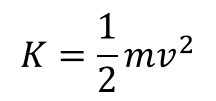
Conservation of Energy
|
The laws of energy are crucial to understanding
how objects move in our physical world. The law
of conservation of energy states that energy
is never created or destroyed, it just changes
from one form to another. In order to be able to
comprehend this law, it is helpful to know a few
types of energy. I'll introduce two very common
types of energy to you, and then show you how they
work with an aerial silks move. First, there is kinetic energy, which is
simply the energy of motion. When a person moves
in any way, they have kinetic energy, as kinetic
energy is dependent on speed. (v= velocity) 
Second, there is energy in the form of gravitational
potential energy. This is also referred to
as the energy of position. When a person is
elevated to any height, they will have an amount
of gravitational potential energy, as potential
energy is dependent on position. (g= acceleration
due to gravity) The unit of energy used in the SI system is called the joule, and it is equal to kg m²/s². So how are these two forms of energy related? Their relationship forms the law of conservation of mechanical energy. This means that when an object moves in an isolated system, the amount by which potential energy changes will directly equal the amount of change in kinetic energy. Here I show the law of
conservation of energy in action with a silks
move called the jump rope drop. I start out
above the ground and have only potential energy
at my starting point (ignore the small amount of
kinetic energy I have in the horizontal
direction as I am slightly swaying). Then as I
let the tension out of the silk, I fall for a
short distance. During the time that I am moving
downwards, in the vertical direction, my
potential energy is transferring into
kinetic energy. At the end of my drop, the slack
in the silk is used up and I am brought to a
stop. At the point just before I come to a stop,
I would have only kinetic energy. [video from N. Gyswyt] To put the motion in the video
above into terms of the equation given for
conservation of mechanical energy:
Kinetic energy initial is equal to zero. Potential energy initial is equal to my mass*acceleration due to gravity*height. Kinetic energy final is equal to one half*my mass*my velocity squared. Potential energy final is equal to zero. If I wanted to solve for my velocity right at the end of my drop, it would be a very simple problem.  By understanding how energy is transferred in a system, you can solve for many different unknown variables. Just begin with the simple equation of conservation of mechanical energy and analyze your system at its initial and final stage. |
| Homepage |
| Newton's
2nd Law |
| Friction |
| Conservation
of Energy |
| Rotation |
| Resources |